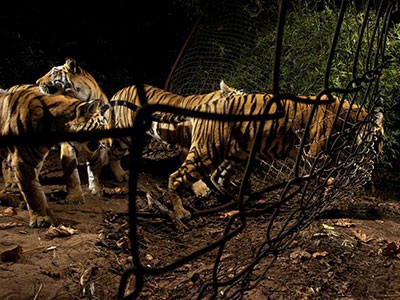
To improve tiger conservation, more scientists need to have access to raw census data.Credit: Karine Aigner/NPL
On Global Tiger Day in July, India’s government announced a victory. It declared that the nation is home to 2,967 wild tigers — a major increase on the 1,872 animals recorded in 1972.
Centuries ago, tens of thousands of tigers roamed the world. Today, only six sub-species remain and the International Union for Conservation of Nature estimates that there are no more than 3,159 individuals in the wild. But, after centuries of hunting and habitat destruction, India’s tigers seem to be turning a corner. However, as we report in a News Feature, there’s much more that could be done.
To begin with, tiger-conservation work must be improved in more of India’s 50 tiger reserves — the current effort is concentrated in just a handful. And the government must give scientists at India’s universities access to the reserves and the raw data on which its tiger estimates are based.
India’s tigers seem to be a massive success story — many scientists aren’t sure
At present, scientists cannot access the full data that the government collects during the national tiger census, which is conducted every four years. This is in spite of the fact that India’s National Data Sharing and Accessibility Policy states that scientific data collected using “public funds” should be made available to those with a legitimate research interest.
If researchers were allowed to see the raw numbers, they could independently verify tiger population estimates. Such verification is essential to knowing whether conservation measures are working. It could also allow scientists to project population trends over time, and estimate birth and death rates. These measures would help officials in the government forestry department to assess populations more accurately and act quickly if they foresee a risk of local extinction. Such action might have helped to prevent the complete loss of tigers from three reserves that the 2018 census reports.
Researchers are also keen to get involved in, and improve, the census itself. The four-yearly survey is a gargantuan effort. The 2018 one covered 381,400 square kilometres and amounted to nearly 594,000 human-days of work. It logged 35 million photographs taken with hidden motion-triggered cameras, yielding almost 77,000 images of tigers.
But instead of trying to count tigers across such a vast area, individual reserves — where 70–85% of India’s tigers are thought to be found — could be sampled more often, and automatic image recognition used to process the pictures.
The slow growth of India’s tiger population is a rare good news story in international conservation. But the Indian government could be doing more. It must trust independent scientists with the raw data, so that one of Earth’s most iconic species can survive long into the future.

 India’s tigers seem to be a massive success story — many scientists aren’t sure
India’s tigers seem to be a massive success story — many scientists aren’t sure




